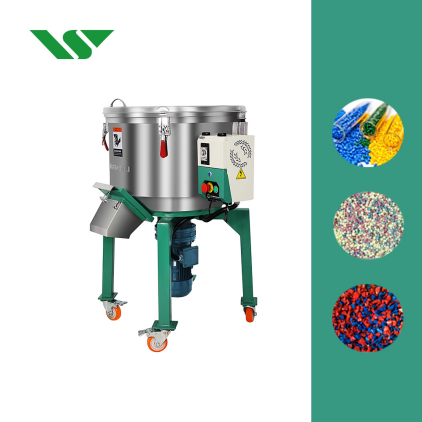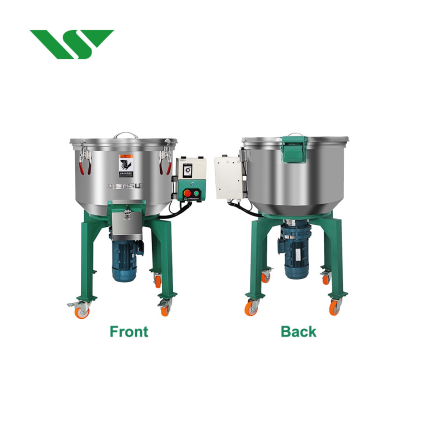Why a Quality Plastic Material Mixer Is a Game-Changer for Manufacturers
2025-05-15 Page view:
Ever wondered how top manufacturers churn out flawless plastic products with precision and speed? The secret lies in a quality industrial mixer—a game-changer that can transform your production line. I’m excited to dive into why investing in the right material mixer is a must for any serious manufacturer. In this post, I’ll explore how these machines ensure consistent blends, break down the types of Industrial material mixers best suited for your needs, highlight their benefits for boosting efficiency and product quality, share key factors to consider when buying, and peek into the future of mixing technology. Whether you’re a small-scale producer or running a large plant, this guide will help you make smarter choices and elevate your manufacturing game!

The Importance of Consistent Mixing in Plastic Manufacturing
I can’t stress enough how vital consistent mixing is in plastic manufacturing. Imagine crafting a batch of plastic components, only to find uneven colors, weak structures, or inconsistent textures. That’s a nightmare for any manufacturer, leading to wasted materials, rejected products, and unhappy customers. A quality industrial mixer ensures uniformity in every batch, blending raw materials like resins, additives, and colorants into a homogeneous mix.
Consistency matters because plastics often involve complex formulations. For example, when I worked with a small injection molding company, they struggled with uneven dispersion of flame-retardant additives, causing some parts to fail safety tests. Switching to a high-quality material mixer solved this by evenly distributing every component, ensuring each product met strict standards. This isn’t just about aesthetics—consistent mixing directly impacts mechanical properties like strength, flexibility, and durability.
Moreover, uniform mixing reduces defects, which saves money and time. I’ve seen manufacturers cut scrap rates by up to 20% after upgrading their Industrial material mixer. It also ensures compliance with industry regulations, especially for applications like medical devices or food-grade plastics, where precision is non-negotiable. A reliable industrial mixer takes the guesswork out of blending, giving you confidence that every batch performs as expected, whether you’re producing packaging, automotive parts, or consumer goods.
Types of Plastic Material Mixers and Their Applications
When I first started exploring plastic material mixers, I was amazed by the variety available, each designed for specific needs. Choosing the right industrial mixer depends on your production goals, material types, and scale. Let me break down the most common types of Industrial material mixers and their applications to help you find the perfect fit.
First, there are high-speed mixers, which I recommend for fast, intensive blending of powders, granules, or additives. These are ideal for PVC compounding or color masterbatch production, where you need rapid dispersion. They use high RPMs to generate heat through friction, which helps bind materials without external heating. I’ve seen these industrial mixers work wonders in plants producing pipes or cables, where speed and uniformity are critical.
Next, ribbon blenders are my go-to for gentle, large-volume mixing. Their horizontal design with rotating ribbons ensures even blending of dry or semi-dry materials, like plastic pellets with fillers. They’re perfect for bulk applications, such as preparing compounds for extrusion. A friend in the packaging industry swears by these material mixers for their ability to handle large batches without damaging delicate additives.
Tumble mixers are another option, especially for small to medium batches. I find them great for specialty plastics, like those used in 3D printing filaments, where you need precise blending without high shear. Their rotating drum design is simple yet effective for mixing powders or granules, making them a reliable industrial mixer for niche applications.
Lastly, planetary mixers shine in applications requiring heavy-duty mixing of viscous materials, like adhesives or thick polymer blends. Their multi-directional mixing arms ensure thorough blending, which I’ve found invaluable for high-performance plastics used in aerospace or medical devices. These Industrial material mixers are built for tough jobs where precision is key.
Each type has its strengths, so I always advise matching the material mixer to your specific materials and production scale. For example, a high-speed industrial mixer might overwhelm delicate additives, while a ribbon blender could be too slow for time-sensitive processes. Understanding these differences helps you invest in an Industrial material mixer that aligns with your manufacturing goals.

Benefits of a Quality Mixer for Efficiency and Product Quality
I’ve seen firsthand how a quality industrial mixer can revolutionize a production line. The benefits of a top-notch material mixer go beyond just mixing—they impact your bottom line, product quality, and even your team’s morale. Let’s dive into why a high-quality Industrial material mixer is worth every penny.
First, efficiency is a game-changer. A quality industrial mixer reduces mixing time significantly. I once visited a factory that upgraded to a modern high-speed material mixer and cut their blending cycle from 20 minutes to 8 minutes per batch. That’s more than double the output in the same timeframe! Faster mixing means higher throughput, allowing you to meet tight deadlines or scale up production without extra shifts.
Energy efficiency is another big win. Older industrial mixers often guzzle power, but newer Industrial material mixers with advanced motors and controls use less electricity while delivering better results. I’ve read case studies where manufacturers reduced energy costs by 15% after switching to energy-efficient material mixers. That’s money you can reinvest into your business.
Product quality is where a good industrial mixer truly shines. A uniform mix eliminates issues like streaks, weak spots, or inconsistent properties in the final product. For instance, I helped a client in the automotive industry troubleshoot defects in plastic dashboards. Their outdated material mixer was causing uneven colorant dispersion. A new, high-precision Industrial material mixer solved the issue, and their rejection rate dropped by 25%. Better quality also builds customer trust, leading to repeat business and a stronger reputation.
Finally, modern industrial mixers often come with automation features, like programmable settings or real-time monitoring. These reduce human error and free up your team to focus on other tasks. I’ve seen operators go from babysitting a material mixer to overseeing multiple processes, boosting overall productivity. In short, a quality Industrial material mixer streamlines operations, cuts costs, and delivers products that meet or exceed expectations.
Key Factors to Consider When Buying a Plastic Material Mixer
Buying a plastic material mixer isn’t a decision I’d make lightly—it’s a significant investment that can make or break your production. To help you choose wisely, I’ve outlined the key factors I always consider when advising manufacturers on selecting an industrial mixer.
Capacity is my first checkpoint. You need an Industrial material mixer that matches your production volume. A small material mixer will bottleneck a large plant, while an oversized industrial mixer wastes energy and space for smaller operations. I suggest calculating your average batch size and choosing a material mixer with 10-20% extra capacity for flexibility.
Material compatibility is critical. Not all industrial mixers handle every plastic or additive well. For example, abrasive materials like glass-filled polymers require robust stainless steel construction to prevent wear. I once saw a cheap material mixer fail in months because it wasn’t designed for the abrasive fillers the manufacturer used. Check the Industrial material mixer’s specs for compatibility with your resins, additives, and fillers.
Ease of maintenance is another must. Industrial mixers with complex designs can be a headache to clean or repair, leading to downtime. I prefer models with accessible parts and quick-release mechanisms for easy cleaning, especially for industries like medical plastics, where contamination is a no-go.
Automation and controls can save you time and money. Look for material mixers with user-friendly interfaces, programmable settings, and sensors for monitoring mix quality. I’ve worked with manufacturers who reduced errors by 30% after switching to industrial mixers with automated controls.
Cost vs. value is the final piece. A cheap material mixer might seem appealing, but I’ve seen too many fail prematurely or deliver inconsistent results. Consider long-term savings from energy efficiency, durability, and reduced waste. I always recommend getting quotes from multiple suppliers and checking reviews or case studies to ensure you’re investing in a reliable Industrial material mixer.
By weighing these factors, you’ll find an industrial mixer that fits your budget, meets your production needs, and delivers consistent results for years.
Future Trends in Plastic Mixing Technology
As someone who loves staying ahead of the curve, I’m excited about where industrial mixer technology is headed. The industry is evolving fast, and I see trends that will make material mixers smarter, greener, and more efficient. Here’s what I’m keeping an eye on for 2025 and beyond.
Smart mixers with IoT integration are gaining traction. These Industrial material mixers connect to your network, allowing real-time monitoring and data analysis. I’ve read about plants using IoT-enabled industrial mixers to track performance metrics like mixing time, energy use, and material consistency, optimizing processes on the fly. Imagine getting an alert if your mix is off-spec before it ruins a batch—that’s the future!
Sustainability is another big driver. Manufacturers are under pressure to reduce waste and energy use. I’m seeing material mixers designed with eco-friendly features, like low-energy motors or systems that recycle excess material. Some industrial mixers even integrate with closed-loop systems to reuse scrap plastic, which I think is a brilliant way to cut costs and environmental impact.
AI-driven mixing is on the horizon. I’ve come across prototypes of Industrial material mixers that use AI to adjust mixing parameters in real time based on material properties or environmental conditions. This could revolutionize industries like medical plastics, where precision is paramount. AI could also predict maintenance needs, reducing downtime—a huge win for busy plants.
Finally, modular designs are making industrial mixers more versatile. Instead of buying a new material mixer for different applications, you can swap out components like blades or drums. I’ve spoken to manufacturers who love this flexibility, as it lets them adapt to new products without massive investments.
These trends excite me because they promise better performance, lower costs, and a smaller environmental footprint. Staying informed about these advancements will help you choose an Industrial material mixer that’s future-proof and ready for tomorrow’s challenges.

Conclusion
Investing in a quality industrial mixer isn’t just about upgrading equipment—it’s about transforming your manufacturing process. I’ve shown how consistent mixing ensures top-notch products, explored the types of material mixers available, highlighted their efficiency and quality benefits, shared tips for choosing the right Industrial material mixer, and peeked into the exciting future of mixing technology. By picking an industrial mixer that aligns with your needs, you’ll boost productivity, cut costs, and deliver products that keep customers coming back. Ready to take your production to the next level? Start exploring material mixers today, and feel free to reach out if you need help narrowing down your options!



